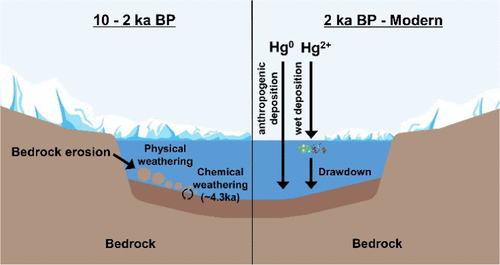当前位置:
X-MOL 学术
›
ACS Earth Space Chem.
›
论文详情
Our official English website, www.x-mol.net, welcomes your
feedback! (Note: you will need to create a separate account there.)
Climate-Associated Changes in Mercury Sources in the Arctic Fjord Sediments
ACS Earth and Space Chemistry ( IF 2.9 ) Pub Date : 2021-08-22 , DOI: 10.1021/acsearthspacechem.1c00095 Ju Hyeon Lee 1 , Sae Yun Kwon 1, 2 , Hoin Lee 1 , Seung-Il Nam 3 , Jung-Hyun Kim 3 , Young Ji Joo 3 , Kwangchul Jang 3 , Haryun Kim 4 , Runsheng Yin 5
ACS Earth and Space Chemistry ( IF 2.9 ) Pub Date : 2021-08-22 , DOI: 10.1021/acsearthspacechem.1c00095 Ju Hyeon Lee 1 , Sae Yun Kwon 1, 2 , Hoin Lee 1 , Seung-Il Nam 3 , Jung-Hyun Kim 3 , Young Ji Joo 3 , Kwangchul Jang 3 , Haryun Kim 4 , Runsheng Yin 5
Affiliation

|
Despite the large climatic fluctuations in the Arctic over the Holocene, the dominant mercury (Hg) sources and the potential changes in Hg sources associated with the climate remain unclear. Here, we use Hg isotopes to reconstruct changes in Hg sources and processes in two Svalbard fjord sediment cores spanning the Holocene. The Hg isotope ratios of the fjord sediment cores are similar to bedrock and Hg bound to terrestrial total organic carbon (TOC) but different from other sediment cores influenced by atmospheric Hg drawdowns via the sinking of marine particulate organic matter. The absence of significant Hg and TOC relationships indicates that bedrock erosion caused by glacier dynamics is the major Hg source to the fjord sediment rather than those bound to marine and terrestrial TOC. Measurable shifts in Hg sources are observed at regional cooling (4.3 ka) and during the Medieval Warm Period in the late Holocene. The negative shift in δ202Hg (by −0.5‰) at 4.3 ka from baseline (∼10 ka) is consistent with the rapid increase in glacier-mediated physical and chemical erosions of bedrock. The significant positive shifts in δ202Hg (by 0.5‰) in the late Holocene are explained by enhanced input of atmospheric Hg and its drawdown via the sinking of marine particulate organic matter and some anthropogenic influence, which suppressed the positive Δ199Hg and Δ200Hg shifts. This study suggests that Hg isotope ratios measured in sedimentary archives can be used to decipher climate and other local to global changes modifying Hg sources in the Arctic.
中文翻译:

北极峡湾沉积物中汞来源的气候相关变化
尽管全新世北极地区气候波动较大,但主要的汞 (Hg) 来源以及与气候相关的汞来源的潜在变化仍不清楚。在这里,我们使用汞同位素来重建跨越全新世的两个斯瓦尔巴群岛峡湾沉积岩心中汞来源和过程的变化。峡湾沉积物核心的 Hg 同位素比与基岩和与陆地总有机碳 (TOC) 结合的 Hg 相似,但与通过海洋颗粒有机物下沉受大气 Hg 下降影响的其他沉积物核心不同。缺乏显着的 Hg 和 TOC 关系表明冰川动力学引起的基岩侵蚀是峡湾沉积物的主要 Hg 来源,而不是那些与海洋和陆地 TOC 结合的汞来源。在区域变冷 (4.3 ka) 和全新世晚期的中世纪暖期期间观察到汞源的可测量变化。δ 的负移距基线(~10 ka)4.3 ka 处的202 Hg(-0.5‰)与冰川介导的基岩物理和化学侵蚀的快速增加一致。全新世晚期δ 202 Hg的显着正移(0.5‰)可以解释为大气 Hg 输入增加及其通过海洋颗粒有机物下沉和一些人为影响的下降,这抑制了正 Δ 199 Hg 和 Δ 200 Hg 变化。这项研究表明,在沉积档案中测量的汞同位素比率可用于破译气候和其他改变北极汞来源的局部到全球变化。
更新日期:2021-09-16
中文翻译:

北极峡湾沉积物中汞来源的气候相关变化
尽管全新世北极地区气候波动较大,但主要的汞 (Hg) 来源以及与气候相关的汞来源的潜在变化仍不清楚。在这里,我们使用汞同位素来重建跨越全新世的两个斯瓦尔巴群岛峡湾沉积岩心中汞来源和过程的变化。峡湾沉积物核心的 Hg 同位素比与基岩和与陆地总有机碳 (TOC) 结合的 Hg 相似,但与通过海洋颗粒有机物下沉受大气 Hg 下降影响的其他沉积物核心不同。缺乏显着的 Hg 和 TOC 关系表明冰川动力学引起的基岩侵蚀是峡湾沉积物的主要 Hg 来源,而不是那些与海洋和陆地 TOC 结合的汞来源。在区域变冷 (4.3 ka) 和全新世晚期的中世纪暖期期间观察到汞源的可测量变化。δ 的负移距基线(~10 ka)4.3 ka 处的202 Hg(-0.5‰)与冰川介导的基岩物理和化学侵蚀的快速增加一致。全新世晚期δ 202 Hg的显着正移(0.5‰)可以解释为大气 Hg 输入增加及其通过海洋颗粒有机物下沉和一些人为影响的下降,这抑制了正 Δ 199 Hg 和 Δ 200 Hg 变化。这项研究表明,在沉积档案中测量的汞同位素比率可用于破译气候和其他改变北极汞来源的局部到全球变化。











































 京公网安备 11010802027423号
京公网安备 11010802027423号